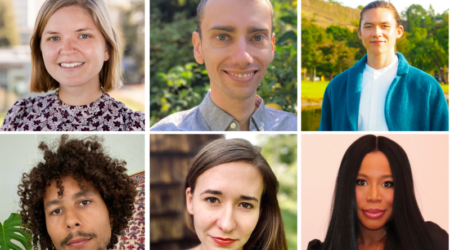In the wake of recent decisions on abortion, First Amendment rights, gun rights, Miranda rights, and jurisdiction over Native American reservations, the Supreme Court today seems particularly out of sync with the American people.
On October 20, Social Science Matrix hosted a “Matrix on Point” panel featuring UC Berkeley experts discussing what these decisions and the conservative turn in the Supreme Court mean for the relationship between the Court and the people.
The panel featured Erwin Chemerinsky, Dean, Jesse H. Choper Distinguished Professor of Law at Berkeley Law; Thomas Biolsi, Professor of Comparative Ethnic Studies and Native American Studies in the Department of Ethnic Studies, UC Berkeley; and Khiara M. Bridges, Professor of Law at UC Berkeley School of Law. The panel was moderated by Ronit Stahl, Associate Professor in the UC Berkeley Department of History. This event was co-sponsored by the UC Berkeley School of Law.
“We have assembled a stellar group of Berkeley faculty,” said Marion Fourcade, Professor of Sociology and Director of Social Science Matrix. “As scholars, they can offer us historical grounding and insights that move us beyond the headlines. And we are really thrilled to have them here to discuss this enormously consequential ideological shift, or series of ideological shifts.”
Ronit Stahl agreed that “it has been a really transformative several years at the Supreme Court with new justices, and quite a few decisions that have shifted the landscape of American law in a range of domains.”
In his remarks, Dean Chemerinsky provided a concise summary of some of the recent Supreme Court cases and their broader implications. “I don’t think it’s hyperbole to say that the last year in the Supreme Court was the most dramatic term in my lifetime,” he said. “It was a year in which the Supreme Court changed the law not incrementally, but dramatically. It was a year in which the Supreme Court dealt not with minor or technical issues, but with enormously important questions that affect all of us, often in the most important, most intimate aspects of our lives.”
Chemerinsky provided an overview of “how we got here,” including the partisan appointments of conservative justices by Republican presidents. “Between 1960 and 2020, Republican presidents picked 15 justices of the Supreme Court, and Democratic presidents picked only eight justices,” he said. “That’s an almost two-to-one difference. President Donald Trump picked three justices in his four years in the White House. The prior three Democratic presidents, who spent combined 20 years in the White House, picked only four Supreme Court justices.”
The Berkeley Law dean highlighted select recent decisions, including Dobbs v. Jackson Women’s Health Organization, which overturned Roe v. Wade and ruled that abortion is not a constitutional right. “It is rare in all of American history that the Supreme Court has taken a right away from people,” Chemerinsky said, “That’s exactly what the Supreme Court did, putting many people’s lives in jeopardy, putting many people’s health in jeopardy, and making abortion what is going to be the dominant issue in our political and legal process for years to come.”
Chemerinsky talked through other recent decisions on issues such as religion and gun rights, and noted that the conservative trend is sure to continue in the near- and long-term future. “This term again, the Supreme Court has cases that are likely to dramatically change the law and push it much further to the right,” he said. “I don’t think anyone, liberal or conservative, has much doubt what the Supreme Court is going to overrule 44 years of precedent and eliminate affirmative action. What a devastating effect that’s gonna have on diversity in higher education. What will it mean to have a court that’s come down so solidly on one side of that political divide? What will it mean for our society to have a Court that so lost its legitimacy?”
In his remarks, Thomas Biolsi focused on recent Supreme Court cases related to Native American territories, including McGirt v. Oklahoma, a 2020 case with a majority opinion written by Neil Gorsuch. “What this decision did was to basically declare that most of eastern Oklahoma is still what’s technically called, in Federal law, ‘Indian country,’ and that the reservations that had been established there in the 19th century were still legal in the territory, in which tribal governments have very expansive rights of self-government. And the state of Oklahoma has very limited intrusion into that.”
The decision was described as the “Indian law bombshell,” Biolsi said, because “what it did was to change the jurisdictional map, literally, of Oklahoma. So tribal governments have jurisdiction over Native people throughout these reservations. And more importantly, the state of Oklahoma does not have criminal jurisdiction.”
This finding, however, was “quickly counterbalanced” by another case, Oklahoma vs. Castro-Huerta, which “declared that the state of Oklahoma has concurrent criminal jurisdiction with the federal government over any non-Indian who commits a crime against an Indian person.”
Biolsi noted that this case “is perceived in Indian country as a great loss for tribal sovereignty,” as it held that “the state has jurisdiction over non-Indian people on the reservation…. The principle from the tribes’ point of view should be a government-to-government relationship, in which the state does not try to enter the territory of the tribe.”
In her remarks, Professor Khiara M. Bridges provided an overview of the history of Dobbs decision, including an explanation of how abortion laws have evolved since Roe v. Wade. The court’s decision in that 1973 case was remarkable, Bridges said, in part because “several of the justices in the majority were appointed by Republican presidents,” and the issue of abortion was “much less partisan.”
Still, she said, the decision was “derided and criticized from the moment that it was handed down, and anti-abortion activists and advocates immediately began brainstorming ways to limit Roe. And the end goal, of course, was to overturn it.”
Bridges traced the history through subsequent cases, including Planned Parenthood v. Casey, which “said that a woman’s right to terminate her pregnancy before viability is the most central principle of Roe. It is a rule of law and a component of liberty we cannot renounce.”
The decision did, however, “replace the trimester framework with the undue burden standard,” which allowed states to impose regulations throughout the entirety of pregnancy. “The states were permitted under the undue burden standard to promote fetal life throughout pregnancy, and states could do that through the informed consent process by telling pregnant folks that their abortion will kill the life of a separate unique living human being, which is what North Dakota and South Dakota required physicians to tell pregnant folks before terminating a pregnancy,” Bridges explained. “The undue burden standard allowed states to erect obstacles in front of abortion care, and many of those obstacles would be surmountable by people with privilege…, but were insurmountable by folks without privilege, people who are poor, people who lived in rural areas, people who had disabilities, people who were young, or people who were undocumented.”
Bridges explained that everything changed with the Dobbs decision, as Justice Alito “argued that Roe was egregiously wrong, and as such the court was not bound… to respect it as precedent.” Alito’s decision “interpreted the 14th Amendment due process clause to protect a right to terminate a pre-viability pregnancy,” Bridges said. “According to the majority, because the clause only protects the rights that are ‘deeply rooted in this Nation’s history and tradition’ and ‘implicit in the concept of ordered liberty’.”
“Alito canvassed3 abortion regulations in and around 1868, and concluded that abortion rights are not part of the nation’s history and tradition,” Bridges said. “The painfully obvious point is that folks capable of pregnancy were not part of the body politic during the period of the nation’s history that the majority believes is decisive of the constitutional inquiry…. As Justice Breyer explains, in his dissent, people did not ratify the 14th Amendment, men did. So it is perhaps not so surprising that the ratifiers were not perfectly attuned to the importance of reproductive rights for women’s liberty, or for their capacity to participate as equal members of our nation.”
Bridges also noted that the choice of 1868 was a selective history, as the social movement to criminalize abortion only began in the 19th century, as it was led by “white obstetrician male gynecologist interested in taking the fields of obstetrics and gynecology away from those who had been deemed experts in that field before: midwives.”
She also pointed out that the selection of 1868 as a benchmark for modern laws “does not bode well for the persistence of other fundamental rights that earlier iterations of the court have found in the due process clause,” such as the right to obtain contraception or to marry or have consensual sex with an adult of the same sex.
“The methodology of constitutional interpretation that the majority deploys to return the question of abortion’s legality to the states could be just as easily be deployed to do the same with regard to the legality of contraception, the legality of same-sex sex, and the legality of same-sex marriage. And as a reproductive justice scholar, I want to point out that I can make the same point about the right to be free from coerced sterilization.”


